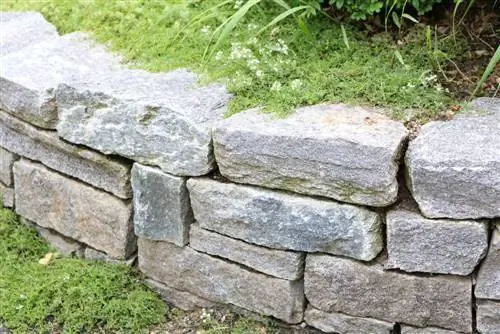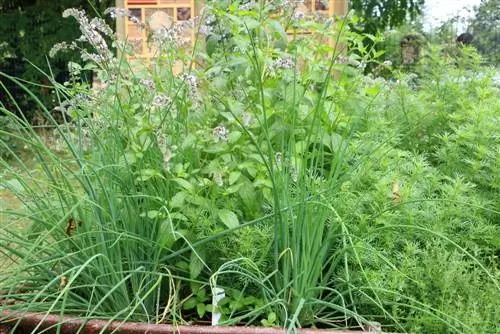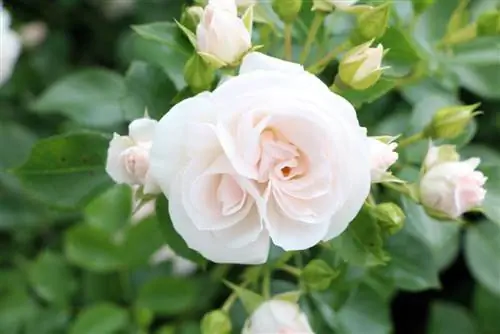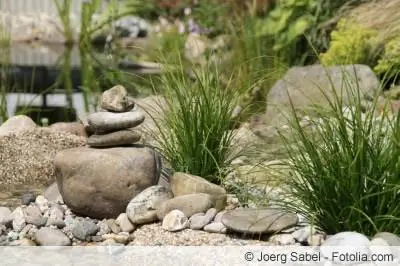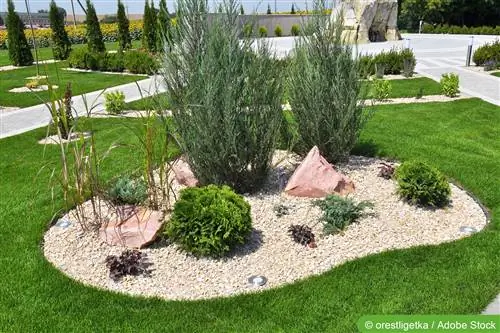- Author admin [email protected].
- Public 2023-12-17 03:39.
- Last modified 2025-01-24 12:45.
A sporadically planted area in the garden that is covered with gravel or gravel is called a stone bed, gravel bed or gravel bed. A stone bed has absolutely nothing to do with a rock garden, because in a rock garden the soil is so emaciated by rubble and sand that only drought-resistant plants from mountain regions grow on it. A stone bed, on the other hand, is built on normal garden soil. In addition, a root fleece protects the system from unwanted weed growth. In short: The purpose of a stone bed is to always look clean and prevent weeds.
Design
A stone bed differs from normal beds in the garden primarily because of its sparing use of plants. Only a particularly bizarre or eye-catching bush or small tree, a group of grasses or even one or two solitary bushes should be specifically showcased here. It is therefore very important to carefully select the plants and trees and place them particularly cleverly in the bed. When composing the plants, it is important that two or three groups of grasses, perennials or trees have different sizes.
Terrain modeling
A stone bed does not necessarily have to be created on a flat surface. A wide variety of possibilities often arise from the natural course of the terrain. Instead of balancing the height of embankments with palisades or a wall, a stone bed offers a much simpler and more interesting alternative. For example, a single boulder made of the same rock as the fill for the stone bed can be used to support the embankment.
Selection of stones
Another design element for the stone bed is of course the stones for the bed itself. A wide variety of stone types, colors, grain sizes and surface structures are possible here. Too many different materials usually do not lead to the desired result and instead only cause visual confusion. It's better to limit yourself to one material. This can of course be used in two different colors to loosen things up. The stones should also match the immediate surroundings.
- House facade (clinker brick, plastered, slate etc.)
- Material on sidewalks, driveways or patios
- are other stones used on walls or similar
- which rock dominates the surrounding area
Only if the stone bed is visually coordinated with the surroundings can it be effective and not visually intrusive. Examples of suitable materials are:
- classic decorative gravel: rounded surface, ideal size 16/25 to 25/40
- Decorative chippings: cheaper than gravel, more suitable for sidewalks, ideal grain size 8/16 to 16/32
Tip:
When choosing a color, it should be borne in mind that pure white stones usually need to be cleaned after a few years.
Instructions
Only a very carefully laid out stone bed is a guarantee of an easy-care system. Therefore, a lot of care should be put into planning and execution.
Preparation
Before you create the stone bed, the area must be dug up and carefully cleared of old roots and weeds. A few days later, the top layer of soil can be removed. This is usually around 10 to 15 cm. If you want to build a walkway on the stone bed, you either have to compact some gravel underneath or plan a 5 cm thick layer of sand.
Excavation
The depth at which the soil must be dug for the stone bed depends on the size of stone with which the bed is to be filled later. In principle, the following applies: approximately three times the height of the largest stone diameter should be excavated. For example, for gravel with a grain size of 16/32, this is around 9 cm of stone layer. There is also an approximately 2 cm thick layer of sand, which ensures good drainage under the root fleece. For most fillings, at least 10 cm of earth is necessary.
Border
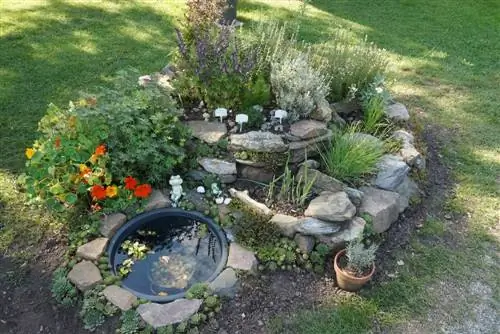
To stabilize the gravel or gravel layer, it makes sense to provide the stone bed with a border. Otherwise, when it rains or is walked on, the stones will be permanently carried outwards and the clear contours that make the stone bed look so attractive and clean will be blurred. Various materials are possible as a border. Popular borders are:
- Lawn edge stones
- Plastic shaped edges (suitable for curved borders)
- Wooden planks
Walks should always be bordered. The same applies to areas with different gravel or gravel fillings. This is the only way to guarantee that the stones do not mix with each other at the interface over time.
Boulders, columns or other design elements
If heavy or high elements are to be integrated into the stone bed, they must be placed a little deeper in the ground for good stability. Narrow, high columns should be buried about a third of the way into the ground and placed in a concrete bed so that they do not later become crooked due to washing out or even fall over.
Dig planting holes
It's easier if you dig the holes for later planting before laying the root fleece. Dig planting holes that are at least twice the size of the root balls. If the soil is very heavy, tends to become waterlogged or the area is in the shade, a drainage layer made of sand or gravel makes sense. It is filled with fertile topsoil (with the appropriate pH value for the planned planting).
Sand layer
A layer of sand about 2 cm thick is filled over the entire area, except for the planting holes. This means that rainwater can drain better under the fleece and waterlogging is reduced. If a walkway is planned over the stone bed, an additional layer of sand is necessary under the stone filling. It should be about 5 cm. Depending on the size of the stone, the excavation may have to be a little deeper at this point.
Root fleece
The root fleece, also known as weed fleece, prevents unwanted weeds from growing out of the system later. A weed fleece is therefore necessary so that the stone bed remains easy to care for. Laying doesn't take much work, but the benefits are enormous.
Full-coverage fleece in one piece
If you want to cover the entire stone bed with a large root fleece, first lay the fleece on the bed surface. Where the plants are used, the water-permeable fleece is cross-cut. The cross cuts are made very generously so that not only the root ball, but possibly also drainage and some humus or compost can be filled in.
Nonwoven sheets
Laces 1 m wide are easier to lay than a large fleece in one piece. There is a crucial difference when laying the root fleece in contrast to a large area: the plants are planted before the root fleece is laid out. To lay the strips close to the plant, simply insert the appropriate cuts into the fleece when laying them out.
- Lay the panels overlapping each other by 10 cm
- after laying a strip, fix the fleece with a shovel and stones
Tip:
In both variants, the fleece must be around 5 to 10 cm larger than the area on all sides. The edges are then folded upwards, otherwise the weeds will come through these places first.
Insert plants
It is best to place the plants in a bucket of water before planting so that the root ball can soak up again. It takes a certain amount of time for the roots to spread through the soil and for the plants to be able to absorb water from the environment. When planting, make sure that the ball level is not placed deeper in the soil than before in the pot.
Fill in stones
Finally, the stones are filled into the bed and the surface is smoothed with a board or a rake.
Plant selection for the stone bed

Depending on which accents are to be set in the garden and what the site conditions are, different plants are suitable for a stone bed. In principle: light leaf colors create beautiful contrasts with dark stones, dark-leaved (dark green or red) varieties are suitable for white substrates.
Japanese atmosphere
Japanese gardens are characterized primarily by dwarf trees and foliage perennials.
- Bamboo (Bambusoideae)
- Garden bonsais of various trees
- Japanese maple (Acer japonicum)
- Japanese columnar cherry ('Prunus serrulata 'Amanogawa')
- Japanese spindle bush (Euronymus japonicus)
- Dwarf fan leaf tree (Ginkgo biloba 'Mariken')
Classic gravel bed
Almost anything is allowed here, whatever the site conditions allow. When selecting trees for the background, preference should be given to small or columnar trees. Particularly popular plants are:
- Bearskin grass (Festuca gautieri)
- Boxwood (Buxus)
- Rock Pear (Amelanchier)
- low-growing maple species
- Cushion plants such as carnations, phlox, blue cushions
- Rhododendron and Azalea
- columnar conifers (like rocket juniper)
- dwarf conifers
Mediterranean flair
Mediterranean plants in particular do well in very sunny and dry areas. Since they originally come from warm areas, high temperatures, strong sunlight, nutrient-poor soil and drought have little impact on them.
- Boxwood (Buxus)
- Catnip (Nepeta)
- Lavender (Lavandula)
- Madeira snakehead (Echium candicans)
- Midday flower (Dorotheanthus)
- Sunflower (Helianthemum)
- Thyme (thymus)
- Spurge (Euphorbia)
- Dwarf mussel cypress (Chamaecyparis obtusa)
Tip:
Plants that originally come from mountain regions, i.e. alpine plants, are particularly suitable for light slopes. Among them there are many dwarf trees and ground cover perennials.
Conclusion
A stone bed should always fit harmoniously into the overall ambience of the garden. In addition to choosing the stones for the bed, the right plants are also important. In order for a stone bed to be effective, the planting must only be very spartan. In addition, the few plants should be real eye-catchers. This could be, for example, a special shape or the color of leaves or flowers.

